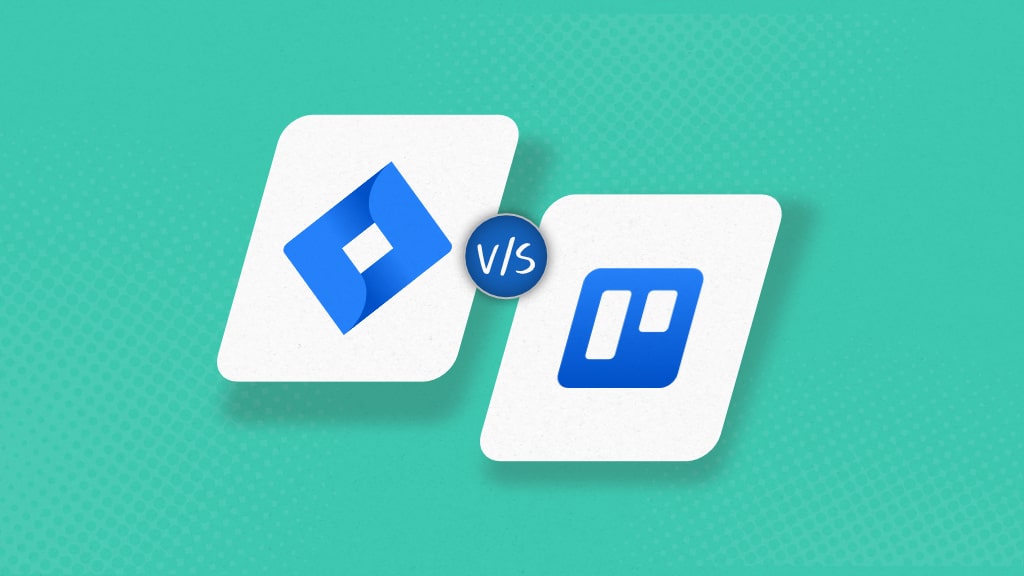Introduction
Jira vs. Trello: Which one is better?
The choice between the two is more than a decision—it’s a strategic move.
As a project manager, not making the right choice can take a toll on your routine operations.
So, I did some deep digging into both Jira and Trello. Thanks to their free trials, I got a hands-on look at what they offer.
Adding more things, my DevOps team pitched in with insights from a developer’s point of view and a look at how agile project management fits in.
We’ll break down both tools, but there might be a better option like ProofHub, which offers a more balanced approach to project management.
Let’s find out and decode their strengths and weaknesses in detail.
What is the difference between Jira and Trello?
Trello and Jira, are products of Atlassian, an Australian Software Company. However, their approach to Agile framework methodologies differs from each other.
The main difference between Jira and Trello is that Jira is designed primarily for software development teams to manage complex projects with advanced features like bug tracking, sprint planning, and customizable workflows, while Trello is a more flexible, visual tool suitable for a variety of project types, using boards, lists, and cards to organize tasks in a simple, user-friendly way.
Neither of them is a one-size-fits-all solution but caters to different user needs.
What is Trello?
Trello is one of the most popular and versatile project management tools. It is renowned for its lightweight approach – a non-structured interface to handle simpler projects.
Since its launch in 2011, Trello has evolved to be a visual workflow management system. Its kanban board functionality presents a visual outlook on your tasks and projects to help you stay on top. You can also move across various stages through its drag-and-drop functionality.
The three-part hierarchy of Trello consists of boards, columns, and cards. Despite its straightforward nature, the platform falls short when handling complex projects. Its design supports short, temporary projects and is great for individuals and small teams.
Pros
- Simple and user-friendly interface
- Provide integration with various apps and tools
- Ideal for small teams
- Free version is available
Cons
- Limited features for managing complex projects
- Lacks advanced reporting and analytics tools
Explore ProofHub vs Trello so you have options to choose from outside the Atlassian family
What is Jira?
Jira, renowned as an issue-tracking tool, is a popular project management platform for software development teams. Jira is known for its agile team support – presenting a structured framework for software development workflows.
Launched in 2002, the platform derives its new name from its previous name “Gojira.” The platform’s adherence to agile methodologies allows teams to track issues, manage projects, and automate workflows.
But what about the teams with sequential workflows or a combination of waterfall and agile?
Jira’s functionalities don’t offer the desired flexibility for workflows like these. However, teams with general requirements may find it overwhelming due to its steep learning curve.
Pros
- Powerful features for Agile project management
- Provide customizable workflows.
- Easy to integrate with other Atlassian products
- Strong reporting and analytics capabilities
Cons
- Steep learning curve especially for new users
- Can be overwhelming for smaller or less complex projects
- Complex setup and configuration
Trello vs. Jira: Head-to-head comparison
For your convenience and understanding, I categorized my evaluation criteria based on the following five parameters.
- Task management
- User experience
- Which tool is best fit for your project needs?
- Pricing
- User reviews and ratings
Let’s look at the difference and assess how they stack against each other.
Jira vs Trello – Task management
| Task management capabilities | Trello | Jira |
|---|---|---|
| Best for | Basic project management and small teams | Software Development Project Management /Agile team and software developers |
| Focus | Visual collaboration, Kanban boards | Issue tracking, Agile project management, Scrum & Kanban |
| Customization | Limited built-in features, rely on Power-Ups | Extensive built-in customization options |
| Reporting & analytics | Basic reports and charts | Robust reporting and analytics functionalities |
| Communication & collaboration | Through comments and mentions | Through comments and mentions; built-in channels |
Trello
Trello is known for its simplistic yet flexible nature. And its Kanban board functionality is what it is best known for. So, if you are a business that wants to stay on top of its daily operations and workflow progressions, Trello is the right way to go.
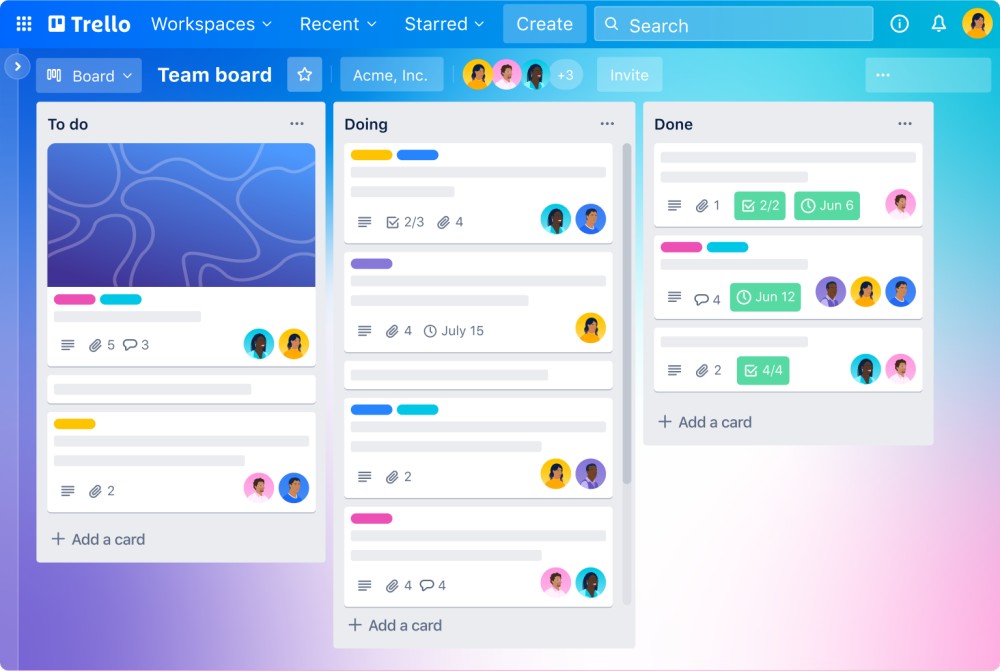
Trello offers a wide range of features that include:
- Kanban board to help you visualize your workflow across different stages. Its drag-and-drop interface allows you to move cards with ease.
- Cards is the generic name for tasks in Trello. These can be moved across lists and contain a wealth of your task information. This includes a description, due dates, a checklist, comments, and attachments.
- Trello has multiple task views, including Timeline, Calendar, Dashboard, Workspace, Table, and Map views. You can choose the view of your choice to get real-time visibility into progress and status.
- Checklists in Trello cards help break down larger tasks into smaller and manageable steps.
- Power-ups and integrations of Trello are potent. You can choose to integrate with 100+ applications, including Slack, Google Drive, and even Jira. You can use these to tailor Trello as per your needs.
- Trello templates provide a seamless way to customize your workflow. The template library spans various categories, making customization super easy.
- Butler automation takes the load off your shoulders by automating whatever you desire.
- Communication and collaboration on Trello cards highly depend on comments and @mentions.
But here’s the catch.
Many powerful Trello features are limited to high-pricing plans. That means you might find it hard to handle complex projects with basic plans.
Check out the Best Trello alternatives & competitors if you are overwhelmed with Trello
Jira
On the surface, Jira shares many similarities with Trello. However, their approach to task management is entirely different. Because Jira is designed to serve software development teams.
So, if you want complete control over your product development cycles, nothing beats Jira. From planning, coding, and deploying to releasing and maintaining software, Jira is a full-fledged solution to your software development needs.
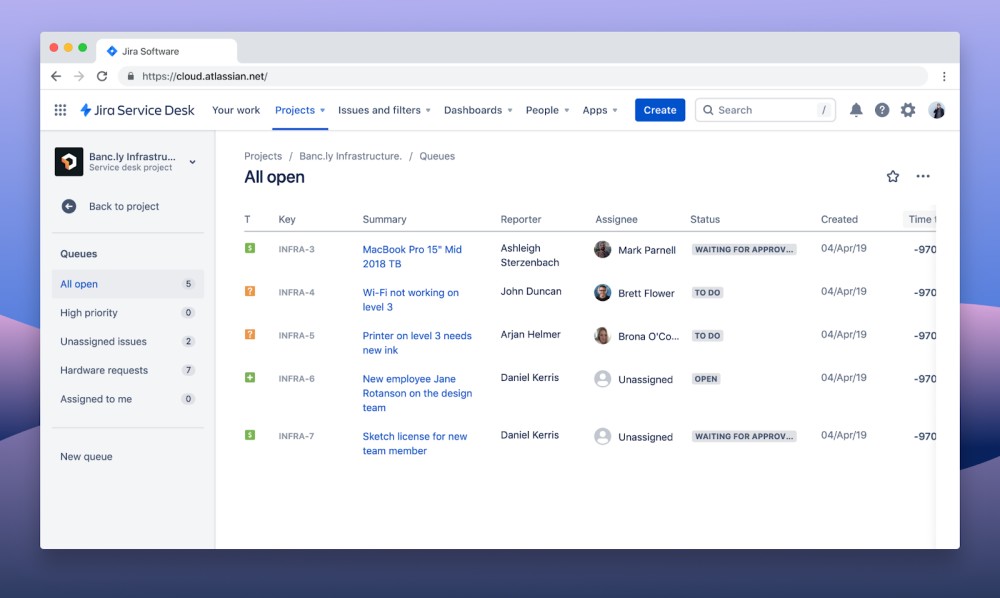
Its product management features for DevOps teams are –
- Jira’s intuitive platform supports two different agile methodologies, namely Scrum and Kanban.
- The platform provides multiple boards while easily adapting to changing work requirements. Scrum boards to break complex boards into more manageable tasks. These tasks are completed in short cycles called sprints. Kanban boards, on the other hand, facilitate visualization across different stages of your workflow.
- Jira’s functions around hierarchy structure. Where Epics take the initial spot. It is a collection of similar subject issues.
- Issues form the basis of Jira. It could represent a project task, story, or bug. These can further be broken down into subtasks. Apart from that, you can even add custom fields and even link issues for defining dependency.
- Workflow represents the roadmap from initiation to completion. Customizing your workflow as per your needs is convenient with Jira.
- Roadmaps present full-scale visibility into project progress.
- Jira’s dashboards and reports offer a comprehensive overview of each sprint. The four reports are Agile, DevOps, Issue analysis, and Forecast and manageable reports. Also, dashboards, charts, and graphs add a layer of visibility to sprint cycles.
- Advanced Jira automation relies on three building blocks: triggers, conditions, and actions.
- Built-in channels in Jira facilitate team communication and collaboration. You can add comments and have discussions.
- With 3000+ integrations, Jira leaves nothing to be explored beyond its intuitive platform.
Jira Work Management (JWM)
JWM is a specialized platform that streamlines your specialized workflow, regardless of the departments. It comes free with Jira software.
- From a simplistic list, board, calendar, and timeline to overviews and summaries, JWM views make it easy to visualize and manage tasks.
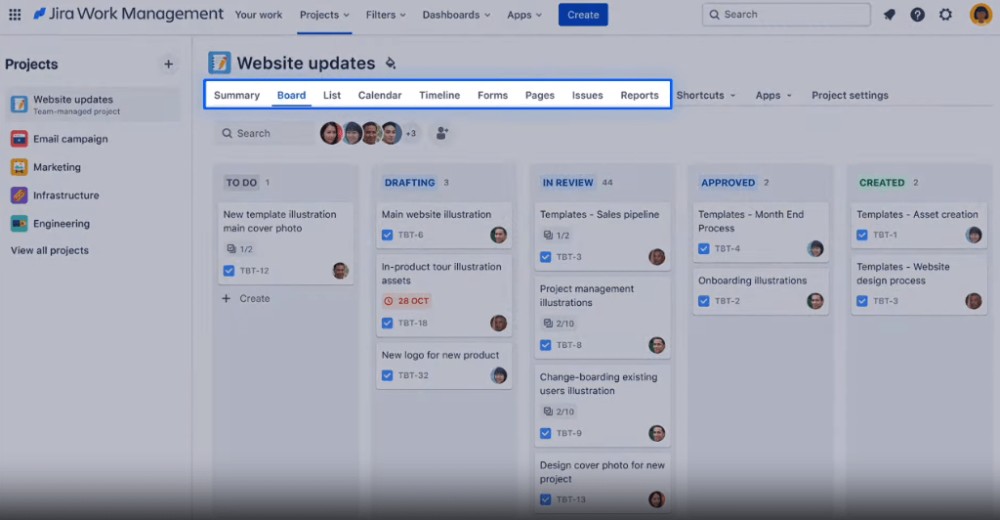
Explore the Best Jira alternatives & competitors for Agile project management
- Enterprise-grade security control to safeguard sensitive information.
- Custom field reporting with 30+ custom fields to generate advanced reports.
- Customizable 23 pre-made templates to build the workflow as per your niche
Jira vs Trello – User experience
Here, I’ve evaluated the user experience based on the following four parameters –
1. Learning curve
If you want an easy-to-grasp project management platform, stick to Trello. Its card-and-board interface allows you to add tasks, set deadlines, and a complete overview of task progress. You just simply need to set it up and start running its simplistic interface immediately.
But if you are a first-time user, you may feel flooded with Jira’s steep learning curve. Why? Because of too many features and menu-drop complexities that come with it. You will need to invest in dedicated efforts to understand its working.
2. Simplicity
Trello wins the game to simplicity over Jira. And the credit goes to its simple and quick-to-use structure. You get a card that has all the task information. To move them across stages, you just simply need to drag and drop them. But when your cards increase, keeping track of them will become extremely difficult for you.
Jira is a feature-rich commendable source of power and support for the DevOps team. But that’s just not at all. It all comes at a price. You need to invest a good amount of effort in understanding its intricacies.
3. Customization options
Trello offers pretty basic customization options. You can set due dates, add labels, checklists, and more. However, you need to rely heavily on Trello Power-ups to add extensive features. This will increase the cost as well as complexity.
Jira hands over control to its users. From adding custom fields to tailoring your task reports, you can tailor the platform according to your team’s needs. Its full-fledged customization eliminates the need for any external tool. But over-customization can simply add to complexity levels.
4. User interface
Trello’s visual Kanban boards are like a whiteboard of your accomplishments and to-dos. Its quick and intuitive user interface is worth admiring. It is suitable for teams requiring a general approach to their project management.
Jira’s tech-savvy user interface is highly recommended for tech-savvy teams. Its powerful built-in features and customization options appeal to users with complex project needs.
Jira vs Trello – Which tool is best fit for your project needs?
Choosing the right project management tool greatly impacts your project health. And the choice greatly depends on what you aim to get out of it.
Before sticking to either of the tools, evaluate your choice based on the following parameters
1. Project type and size
If your workflow follows a linear approach like a waterfall, consider Trello an excellent option. You can manage your tasks with ease using cards and lists. But if your workflow includes complex dependencies, Trello might not be the right fit.
Moving ahead, Jira helps teams deal with multi-layered, complicated projects and dependencies. It includes robust features, like bug and issue tracking, that help you get granular control over your project lifecycle.
2. Team size
Trello’s free plan with unlimited cards and a personal board is a decent choice for individuals and freelancers. But if you are a smaller team, dealing with simple projects, you may find getting yourself a paid pricing plan.
Jira also offers a free plan. However, individual users might feel tangled within its complex structure. Larger teams with intricate projects or data-driven operations can draw in more results from Jira than Trello.
3. Team type
Trello’s functionality suits every team type, provided they have a simple workflow structure. Jira is suitable for teams working in a close relationship with software development. It helps structure your product development cycle while enhancing your project management operations.
The platform is versatile and finds application in other business teams, too. The use cases of JWM are –
- Marketing teams
- HR teams
- Sales teams
- Finance teams
- Operation teams
- Legal teams
- Design teams
4. Project management methodologies
Both tools cater to the diverse needs of agile teams. Trello excels in Kanban methodology by promoting visualization across the workflow. And performs well for projects that follow linear iterations.
Jira supports both Scrum and Kanban methodologies. You can create issues, issue backlogs, plan sprints, and track sprint cycle progression. If you find yourself unfamiliar with what I am talking about here, then Jira is surely not for you.
Jira vs Trello – Pricing
Although both Trello and Jira offer free plans, Trello is more suitable for typical project management needs. I found it to be a bit more user-friendly compared to Jira, which gave my head a spin initially.
Trello’s task management software has three pricing tiers along with one free plan.
- Free plan: $0 for unlimited cards and 10 boards per workspace
- Standard plan: $5 per user per month
- Premium plan: $10 per user per month
- Enterprise plan: $17.50 per user per month (for an estimated 50 users)
The per-user cost of the Enterprise plan decreases as the number of users increases.
Jira exceeded my expectations when I consulted my DevOps teams. They found its free plan pretty generous regarding the key features offered.
Jira’s issue-tracking software has four tiers.
- Free plan: $0 for 10 users with 2 GB storage
- Standard plan: $7.53 per user per month for up to 50000 users
- Premium plan: $13.53 per user per month
- Enterprise plan: Custom pricing
Jira vs Trello – User reviews and ratings
Jira
Jira has a user rating of 4.3 of 5 on G2 and 4.4 of 5 on Capterra.
“I really like how easy is for someone to understand and use it.” – Ioannis S, Quality Assurance Engineer
“I really like that Jira offers different ways to customize the platform that will work for your team.” – Will S, Community Manager
Trello
Trello has a user rating of 4.4 of 5 on G2 and 4.5 of 5 on Capterra.
“This software has truly transformed the way I work, and I can’t imagine going back to a time before Trello.” – Shelby P, Customer Service Representative
“The interface is super intuitive, and setting up boards and organizing tasks feels natural.” –
oyunerdene b, Software Developer
Trello vs Jira: which one to choose?
Trello or Jira? Jira or Trello?
Choosing the right project management tool is crucial to streamline your workflow. It holds the strength to either facilitate or derail your project progressions. Trello and Jira diverge in two different directions despite their owners being the same.
Trello’s flexibility complements businesses with basic project management requirements. Jira, on the contrary, syncs well with the software teams running iterative operations.
However, Trello and Jira’s integration provides the best of both worlds to teams with hybrid workflow – both iterative and linear processes.
Here, I’ve built a Trello vs Jira decision table for you to reach the verdict quickly.
| Capabilities and Features | Trello | Jira |
| Ease of use | Yes | No |
| Gantt chart | No | Yes (through roadmaps) |
| Scalable | No | No |
| Intuitiveness | Yes | No |
| Time tracking | No | Yes |
| Flexibility | Yes | For agile teams – Yes, For other teams – No |
| Built-in chat | No | No |
| Agile adherence | No | Yes |
Beyond Trello and Jira: ProofHub (A better alternative)
When Trello and Jira both fail to meet your expectations, ProofHub becomes the most suitable solution to trust.
ProofHub is an all-in-one project management software and team collaboration with game-changing functionalities and scalable pricing.
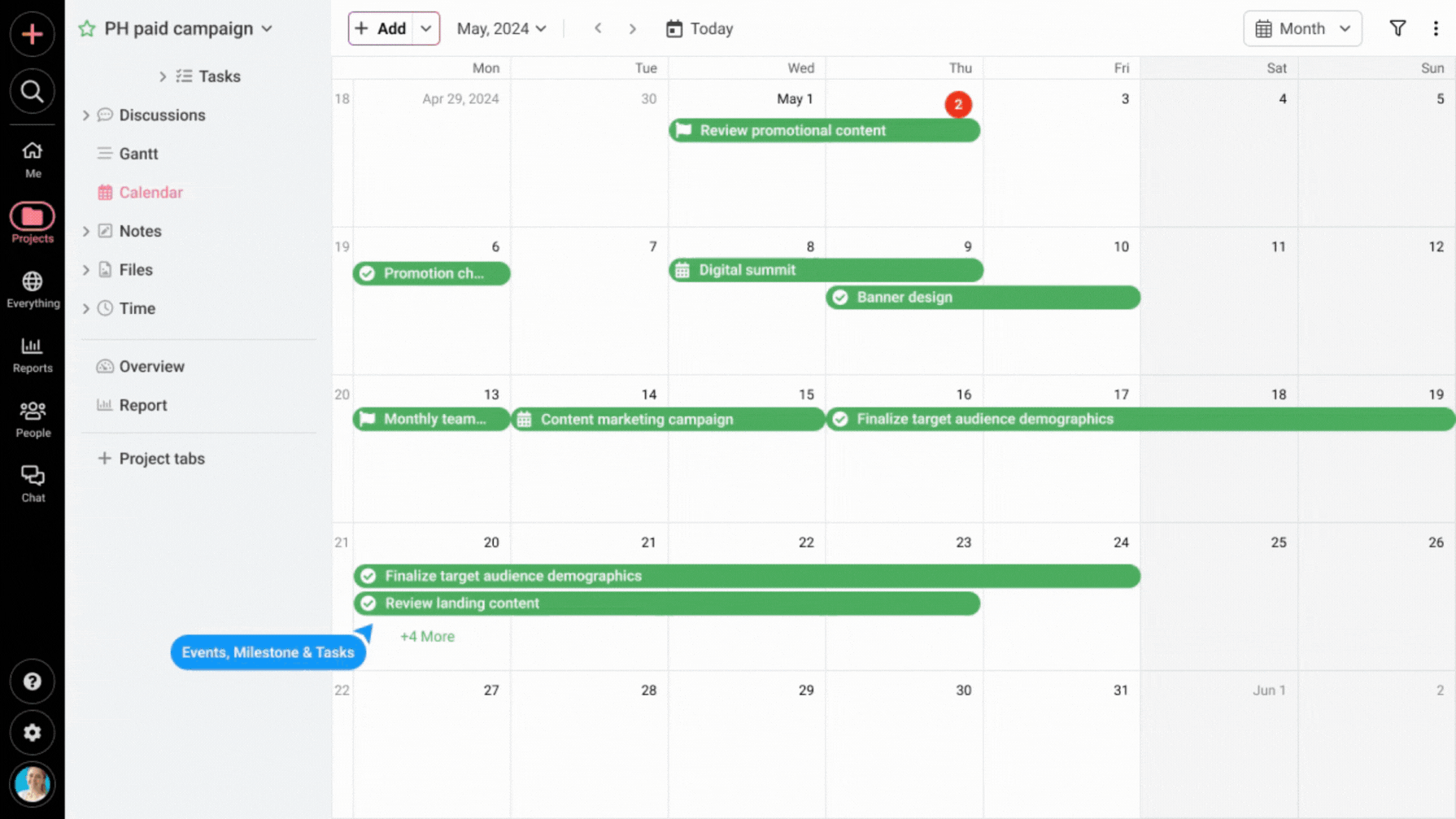
You can find the best of both Trello and Jira under ProofHub’s umbrella. It is a great solution for teams seeking a balanced approach. From catering to small and larger groups and handling simpler to complex projects, ProofHub supports diverse project management styles.
The key features that help ProofHub cut above the competition –
- An all-in-one solution for task management, team collaboration, file storage, online proofing, and more.
- Built-in chat and discussions to facilitate communication and collaboration that both Trello and Jira lack.
- Supports agile methodologies by facilitating sprint planning.
- Gantt chart to create a product roadmap, add goals, and set dependencies and milestones.
- A Centralized platform that brings everything in one place.
- Kanban boards to create, visualize, and manage sprints.
- Powerful project, resources, and time-utilization reports to get visual project insights.
- Customized workflow to match your project and team requirements.
- Flat-fee pricing model to accommodate unlimited users as you scale.
FAQs
Is Jira better than Trello?
Jira is an excellent choice if you are an Agile team or team of developers whose workflow heavily depends on iterative cycles. But if you are just starting with basic project management needs, you must try looking for other great options, like ProofHub, Trello, etc.
What are Jira and Trello used for?
Jira and Trello are both Agile-inspired project management tools. Where Trello adopts a Kanban-style approach, Jira incorporates Scrumban (Scrum + Kanban) methodology. Both are suitable for different use cases.
Can I switch from Trello to Jira?
Yes, switching from Trello to Jira is possible. With the Trello importer, you can shift data directly from Trello to Jira.
How customizable are the workflows in Jira and Trello?
Customizing workflows with Jira is extensive, which might be problematic to understand. On the other hand, Trello, due to its limited functionality, can perform basic customization. It is hugely dependent on power-ups.
Which platform is more user-friendly for beginners, Jira or Trello?
Trello immediately takes the lead here due to its simplistic visual-orient approach to project management. But Jira might be your best fit if you are a software development team.
How do Jira and Trello handle collaboration among team members?
Trello allows team members to collaborate directly on cards using comments, attachments, and mentions. Similarly, Jira offers a comment section in every issue. You can share updates, have task discussions, and ask questions there.
How do Jira and Trello handle scalability as a project grows in complexity and size?
Scaling projects with Jira isn’t a big deal. As the project expands, you can break down your workflow into projects, epics, stories, issues, and subtasks. On the other hand, you can create multiple cards in Trello, but keeping track of them is a bit of a nightmare.
